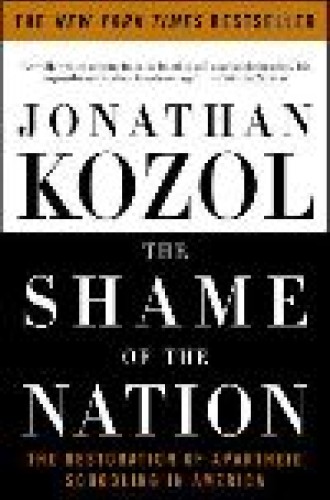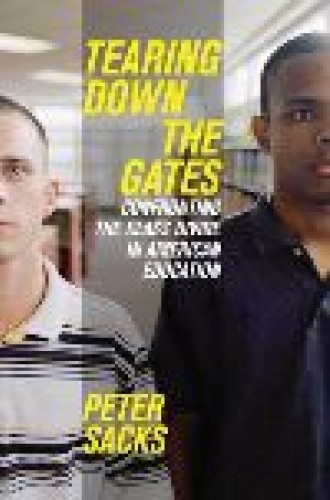Separate and unequal
Jonathan Kozol has made a career of documenting in book after heartbreaking book what poor children of color are asked to endure in school. “The massive desolation of the intellect and spirits and the human futures of these millions of young people in their neighborhoods of poverty” is a “national horror hidden in plain view,” Kozol writes, quoting Roger Wilkins. Why, then, is there no national response? This is the question that drives Kozol’s new book and haunts his readers. Peter Sacks has part of an answer. Transforming public education would require us to debunk one of the most fundamental myths of American culture: the myth of meritocracy.
In The Shame of the Nation, Kozol reveals what school is like for the almost three-fourths of black and Latino students who attend “apartheid schools.” Although we use “linguistic sweeteners and semantic somersaults” and call these schools “diverse,” the Civil Rights Project at Harvard University (now at UCLA) has documented that more than 2 million students, including more than a quarter of black students in the Northeast and Midwest, attend schools in which 99 to 100 percent of the students are nonwhite. What happens in these schools—with their trash, crumbling buildings, overcrowded classrooms, inexperienced teachers, endless stream of substitutes and a “pedagogy of direct command and absolute control”—does not happen in schools that white students attend; nor would it be tolerated in them.
Kozol chronicles the “new emboldenment among the relatively privileged to isolate their children as completely as they can from more than token numbers of the children of minorities.” As an example he points to what happened when New York’s state commissioner of education and the New York Board of Regents considered dissolving the Roosevelt school district (described as “New York’s Soweto” by an official there) and dispersing its students to surrounding schools. The most virulent opposition came from the predominantly white district of East Meadow, and it looked eerily similar to the resistance of white communities in the South to integration a generation earlier. “Keep Roosevelt Students Out of East Meadow,” said a bumper sticker; residents described the children of Roosevelt as “the low-achieving, dysfunctional, criminal bunch . . . which the state wants to dump on us.” Parents passed out flyers that warned of “rampant violence,” “drug sales,” “continual assaults” and “widespread pregnancies.” “Do you want this brought to East Meadow?” residents were asked.
Kozol visits schools where the policies of No Child Left Behind are being enacted. He reveals that even when “school reform” is presented as universal and “applicable to all,” most of the practices are targeted primarily at poor children of color. Kozol brings the reader into several classrooms where teachers have been forced to adopt canned curriculum and disciplinary methods that require almost absolute silence. Students are treated like animals, trained to respond obediently to hand motions, and, like Pavlov’s dogs, are offered fake money for correct answers that can be added to the “classroom bank.”
Kozol describes a poster in one kindergarten classroom that displayed the names of several retail stores: JC Penney, Wal-Mart, Kmart and Sears. “It’s like working in a store,” a classroom aide explained. “The children are learning to pretend they’re cashiers.” Pretending to be a cashier is a wonderful thing if children also pretend to be doctors or teachers or carpenters, but when it is the only career children are encouraged to imagine, it amounts to a severe restriction of possibilities. Kozol’s description of the corporate presence in and influence on schools makes one wonder whether the public education system in the United States has become a domestic version of NAFTA: an effective way for companies to guarantee access to a steady supply of cheap, uneducated labor. Forced to read from scripts and to focus all learning on preparing students to take standardized tests, the teachers that Kozol encounters aren’t treated much differently than their students. Such teaching not only saps classrooms of joy and spontaneity, Kozol argues, it does violence to children and teachers.
We send most poor students of color to school in collapsing buildings. We ask them to learn in overcrowded classrooms, with no supplies and with unprepared teachers. We spend less money to educate them than we do their white counterparts. And then we have the audacity to ask why they don’t perform better on tests. Kozol interviewed a parent from a wealthy school district in Ohio. “We wouldn’t play Little League this way,” she said, reflecting on the inequalities of education funding in her state. “We’d be embarrassed. We would feel ashamed.”
In Tearing Down the Gates, Sacks reveals the great lengths we go to in order not to feel ashamed. Through meticulous research and fascinating interviews with parents and children, Sacks documents the fierce war being waged to keep public education segregated.
Many of the people Sacks interviews cling desperately to the myth of meritocracy that “portrays America as a nation of equal opportunity in which anybody can rise to the top with enough talent and hard work.” Sacks exposes this myth as classist and racist rhetoric designed to blame the poor for being poor and assure the rich that they are rich because they deserve to be. The myth of meritocracy ignores “the informal system of institutional arrangements and economic imperatives that provides great rewards to the children of affluence and privilege but shutters the gates to those who have grown up without such privilege.” Sacks labels this informal system “affirmative action for the rich.” He writes, “American schools and educational policy are structured to enhance the opportunities of culturally, economically, and politically powerful constituencies at the expense of families who lack this human capital.” Because many public schools reinforce “the advantages conferred by the abundant human capital that affluent parents provide their children,” schools have “effectively put themselves in the business of widening school performance gaps between the rich and the not-so-rich, of reproducing the class barriers that exist in the larger society, not lessening them.”
One of the many troubling things that Sacks documents is the creation of school systems within school systems. Selective preschools, tracked classes, small schools within schools and enrichment programs are presented as open to all students but in reality are open only to the children of the most savvy parents—that is, to the children of rich white parents who possess the social and cultural capital to manipulate the institution to serve their needs. He investigates an enrichment program in Boise, Idaho, the Treasure Valley Math and Science Center, that offers challenging classes for “high achieving students.” Designed to meet the demands of “Boise’s growing numbers of affluent families, who sought high-status schools filled with high-status children,” it is a school “created by elites for the children of elites.” Yet it is financed with public money and operated by public officials.
Family values do matter to the educational success of children, Sacks argues. But while conservative rhetoric suggests that parents can simply choose success for their children by providing them with the right values, Sacks demonstrates that parents can essentially buy the right values for their children with sufficient wealth, income, time and knowledge. “Wealth . . . allows families to create the stores of cultural capital that seem to be essential to their children’s success in school.” Sacks cites research that reveals that the number one predictor of academic achievement for children is the economic status of the family into which they are born.
Parents with economic means do everything they can to make sure their children succeed, and rightfully so, but they often do so while giving little or no thought to the consequences of their actions for other children in the system. They create schools for their “intelligent” children to attend, they pay for test preparation programs and tutors, they spend countless hours volunteering in their children’s schools, they raise extraordinary amounts of money for these schools, and they call on their vast network of friends and relatives to get their children into preschools and magnet schools and universities. They use their cultural capital to make sure their children will succeed. And they seem to believe in “trickle-down academics,” as if what they do for their children is good for other children in other districts, when in reality exactly the opposite is true.
Both Kozol and Sacks decipher the language of this army of elite parents—and contemporary versions of educational reform that have adopted their language—as thinly disguised racism and classism. Words like rigor, choice, ability, diversity and intelligence are exposed as codes that legitimate “more invidious ways of sorting by race and class.”
Both The Shame of the Nation and Tearing Down the Gates demonstrate that the obsession with testing is really a way to punish poor students of color for being poor students of color. Instead of committing to helping families and individuals improve their social and economic conditions (by pushing policy makers to strengthen access to affordable housing, health care, child care, public transportation, job training, etc.), we blame them. Instead of combating poverty, we make sure that schools will create more of it. Even programs that seem designed to help poor students of color, both authors suggest, do the opposite. Educational reform efforts often hurt the very students they claim to help.
The myth of meritocracy runs counter to what I understand to be Jesus’ core message: that we measure the health of our communities and the integrity of our souls not by how the wealthy are treated (or treat themselves) but by how the poor are treated. As a Christian, is it possible to speak about earned privilege when others struggle to survive under the same set of rules that made you rich? Is it theologically acceptable to look at your house and your fancy car and your stock portfolio and call yourself blessed? Has the prosperity gospel—the idea that wealth and health are available to Christians through prayer and faith—so perverted the gospel message that Christians believe it is easier for a camel to go through the eye of a needle than for a poor child to enter the kingdom of God?
Sacks calls the increasing emphasis on accountability and on the tests used to enforce it a “brave new meritocracy,” and reveals its history as “laced with absurd elements of eugenics.” While we hold poor students and their families accountable for the education they do not receive, we refuse to hold accountable the people who withhold that education from them. We are a country in denial. Pledging allegiance to the myth of meritocracy, we benefit from a system of oppression, and yet we insist that our privilege is not a privilege but a right. We wear blinders of blame and fear to ensure that the national horror remains hidden, even though it is in plain view.
Kozol shares part of one conversation he had with several high school students about the racial segregation of their neighborhood and school:
“It’s like we’re being hidden,” said a fifteen-year-old girl named Isabel I met some years ago in Harlem. . . . “It’s as if you have been put in a garage where, if they don’t have room for something but aren’t sure they should throw it out, they put it there where they don’t need to think of it again.”
I asked her if she truly thought America did not “have room” for her or other children of her race. “Think of it this way,” said a sixteen-year-old girl sitting beside her. “If people in New York woke up one day and learned that we were gone, that we had simply died or left for somewhere else, how would they feel?”
“How do you think they’d feel?” I asked.
“I think they’d be relieved,” this very solemn girl replied.







